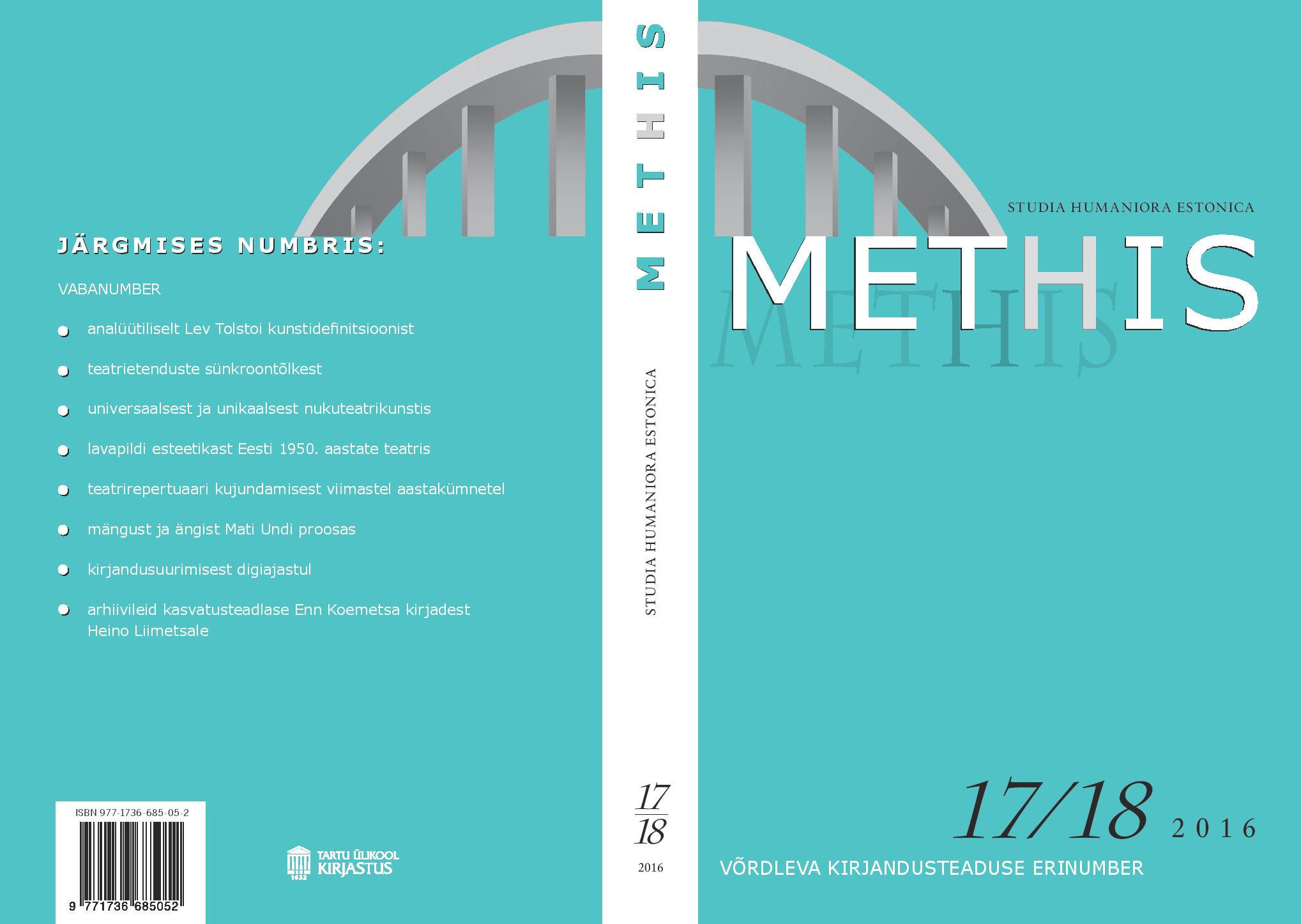Kas "balti kirjanik" on olemas? / Does the "Baltic Writer" Exist?
DOI:
https://doi.org/10.7592/methis.v14i17/18.13219Keywords:
Baltimaad, kirjandus, tõlkekirjandus, regionalism, Soome, Poola, Baltic States, literature, translations, Finland, PolandAbstract
Teesid: Artiklis küsitakse 2009. a ilmunud leksikoni „300 Baltic Writers“ põhjal, kas „Balti kirjanik“ on põhjendatud mõiste. Varem mõisteti Baltikumi all laiemat ala, kuhu kuulusid ka Poola ja Soome. Uurides, kui palju „Balti“ kirjanikke on tõlgitud naaberkeeltesse, selgus, et läti keelde on neid tõlgitud rohkem kui leedu ja eesti keelde. Samuti on eesti autoreid rohkem tõlgitud soome keelde ja leedu autoreid poola keelde. Ilmneb, et Balti kontseptsioon on liiga kitsas, sest relevantne regioon on suurem: soome-eesti ja leedu-poola suhetega võrreldes ei paista eesti-läti-leedu suhe eriti millegagi silma.
The article takes a closer look at the reference guide 300 Baltic Writers (Kalnačs jt 2009) which was published in 2009. The initial (and may-be even provocative) question is, whether the concept “Baltic writer” which is introduced here is indeed as clear and senseful as the introduction suggests. In this introduction, some basic problems occur, as can be exemplified through the following quotations: “This reference book presents a hundred of the best-known writers from each of the three Baltic States, starting with the time in the 16th century when the written word first appeared in their national languages, and going on to the twenty-first century (the bibliography goes up to the year 2008). In doing so, it shows the historical and cultural partnerships between the three Baltic countries.” (p. 5) While the first sentence is comprehensible and correct, the second sentence shows a simple logical mistake: one cannot show a unity simply by putting things together. In doing so, one may create a (wishful) unity, i.e. postulate it, but one cannot show it. Also one of the following sentences is not convincing, but highly problematic: “For a long time, the writers, poets, playwrights and literary critics of each of these countries have deserved to be introduced to a wider international literary audience as a regional phenomenon.” The notion of “regional phenomenon” is problematic here because the definition of a region is arbitrary and several definitions of the region in question are possible. That is why the following question arise: 1. Is the concept of the “Baltic States” (in the meaning of Estonia + Latvia + Lithuania) as it is presented here the only possibility or are other regional divisions thinkable? 2. If there really is one Baltic regional identity or unity, can this also be seen in the interaction between these countries and cultures, e.g. in the number of mutual translations? Is the interaction among the three larger than with others? In dealing with the first question it is stressed that the concept of a “Baltic area” is less stable than assumed, and in previous centuries other regions than only Estonia, Latvia and Lithuania were regarded as “Baltic”. In the Middle Ages, when the concept “Baltic” first emerged in the writings of Adam of Bremen (11th century), even Denmark could be part of the “Baltic area”. Later, one can still find concepts where Finland and Poland are part of the “Baltic area” (cf. Kaslas 1976). And indeed, a closer look on the Finnish-Estonian relations on the one hand and the Polish-Lithuanian relations on the other hand reveals that these relationsships are certainly at least as strong as those between the so called Baltic states. As research on this topic has been carried out earlier (e.g. Kurman 1972), this question is, however, not investigated here in any great detail. The second question is divided into two subquestions: How many writers have been translated into the two other languages, and how many have been translated into the languages of the other neighbours? In order to find answers to these questions, all 300 writers have been examined from the viewpoint of translations into other languages. First of all, how are they translated into the two other “Baltic” languages, i.e.: How many Estonian writers are translated into Latvian and Lithuanian; how many Latvian writers are translated into Estonian and Lithuanian; how many Lithuanian writers are translated into Latvian and Estonian. Then, the neighbours of the larger region were taken into the picture: how many translations into Finnish and Polish we can find? And which authors (from which languages) have been translated? Finally the neighbours of the neighbours, in this case Swedish and Czech, have been considered as well as the four large languages, English, French, German and Russian. The result was that more “Baltic” writers have been translated into Latvian than into Estonian and Lithuanian (table 2), the conclusion being that neighbours are translated more often than cultures farther away. Therefore we find only three Estonian writers who are translated into Lithuanian only (and not into Latvian), and only two Lithuanian authors who are translated into Estonian only (and not into Latvian, table 1). The most interesting and important result was that Estonian authors are much more translated into Finnish, and respectively Lithuanian authors into Polish (tables 3+4). As a final result one can state that the “Baltic” concept is too small because the relevant region actually is larger. When compared to the Finnish-Estonian and the Polish-Lithuanian relationship, the Estonian-LatvianLithuanian relationship is not really eye-catching.


